NDVI stands for "Normalized Difference Vegetation Index". NRG stands for "Near-infrared / Red / Green". NDVI and NRG are both ways to visualize the amounts of infrared and other wavelengths of light reflected from vegetation. Because both these methods compare ratios of blue and red light absorbed versus green and IR light reflected, they can be used to evaluate the health of vegetation. It's a snapshot of how much photosynthesis is happening. This is helpful in assessing vegetative health or stress. (Read more here: https://www.agronomy.org/publications/jeq/articles/36/3/832) ## Do-It-Yourself These techniques for vegetation analysis were developed for satellite imagery, but at Public Lab, we've been working a lot on capturing infrared imagery using our DIY [near-infrared camera](/wiki/near-infrared-camera) setup, and combining it with visible bands to produce NDVI images such as the one above. ## What these images mean What exactly are these images we're trying to make? What do they tell us about vegetation, and why? These diagrams should help to understand what it is we're doing and why these are good ways to analyze plant life. ## The NDVI equation [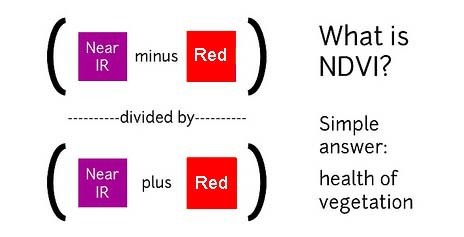](/i/44723) **NDVI = (Near Infrared - Red)/(Near Infrared + Red)** NDVI is a ratio which tries to emphasize photosynthesis while filtering out sun glare. The above equation is run for every pixel, using source data from an infrared photo and a visible light photo, like this pair: [](https://publiclab.org/system/images/photos/000/021/771/original/5390895115_c9d4d38fec_o.jpg) The result can be false-colored to make the high-photosynthesis areas more clear, and used to examine where plants are and how healthy they are. [](https://publiclab.org/system/images/photos/000/021/770/original/PetVISNDVIcomp.png) _Figure above: Normal color photo (right) and normalized difference vegetation index (NDVI) image (left). NDVI image was derived from two color channels in a single photo taken with a camera modified with a special infrared filter. Note that tree trunks, brown grass, and rocks have very low NDVI values because they are not photosynthetic. Healthy plants typically have NDVI values between 0.1 and 0.9. -- @cfastie_ ### Activities Here are a range of activities you can do to produce and interpret your own NDVI imagery, whether downloaded from a satellite imagery provider or [collected yourself using a DIY technique](/wiki/multispectral-imaging) [activities:ndvi] ****   Most DIY converted cameras today (those from Public Lab) use RGN instead of NRG, so the blue channel represents infrared instead of the red channel. That looks like this: [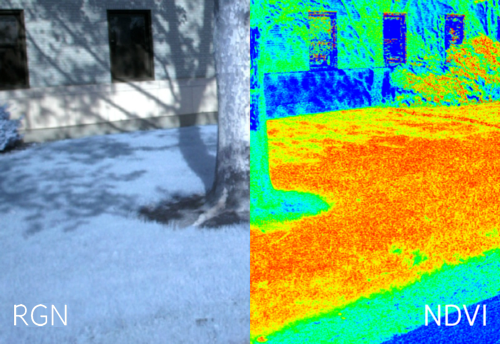](/i/45468?s=o) **** ## NRG imagery Some people are also interested in producing NRG imagery (like the below image), where `Near-Infrared, Red, and Green` are used to compose a picture instead of the usual `Red, Green, and Blue`. [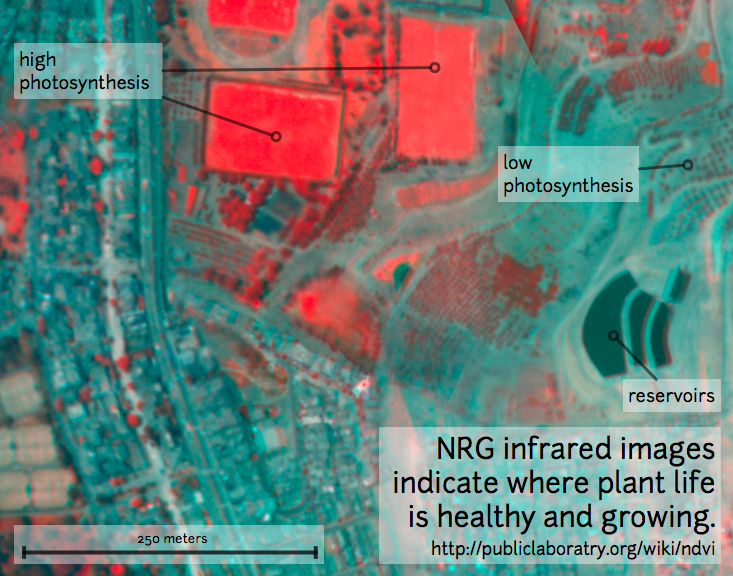](/i/25064) This diagram explains the swapping, which allows us to 'see' infrared as if it were a normal color: [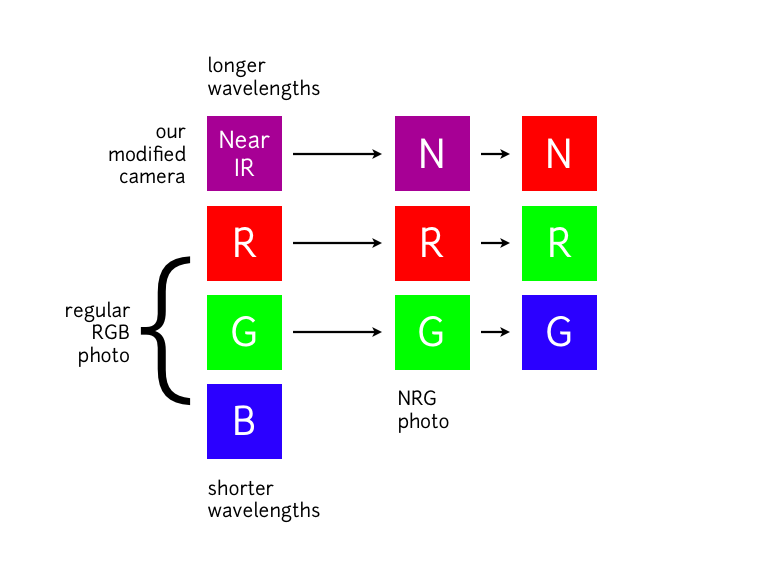](/i/25063) **In NRG images, the deeper and clearer the red color, the denser and healthier the vegetation (more or less).** ### Questions [questions:ndvi] ### Other examples of DIY NDVI imaging From around the internet: Begin watching at 2 minutes to see the resulting imagery: *This topic is part of the [Grassroots Mapping Curriculum](/wiki/mapping-curriculum) series.* **** [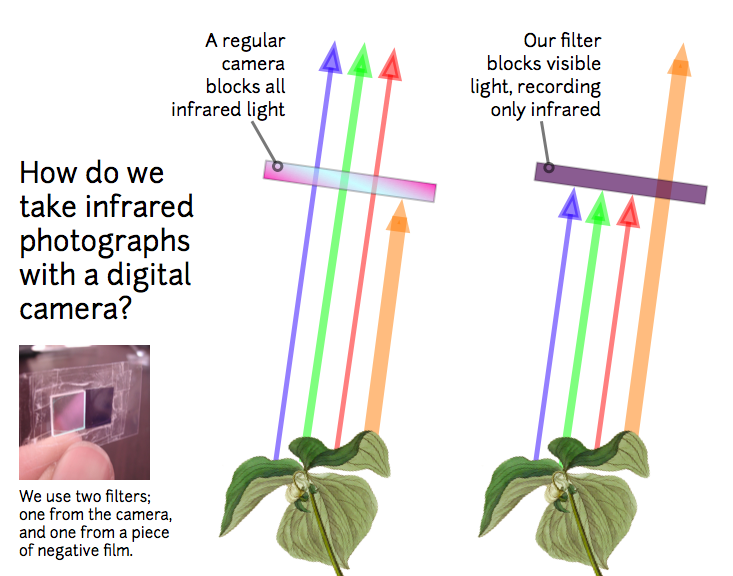](/i/25066) [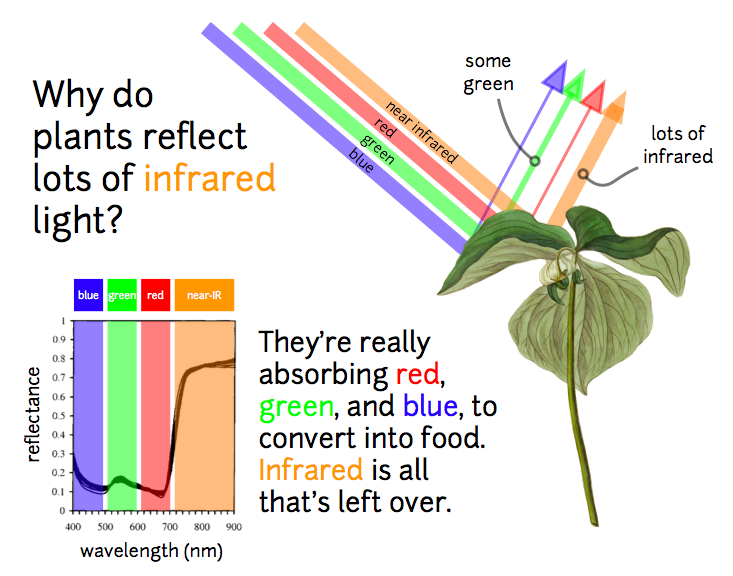](/i/25065) ...
| Author | Comment | Last activity | Moderation | ||
|---|---|---|---|---|---|
| nestocean85 | "https://onlinemocktest2.blogspot.com/2020/06/sbi-po-2021-exam-important-information.html good one " | Read more » | over 4 years ago | |||
| nestocean85 | "https://onlinemocktest2.blogspot.com/2020/06/sbi-po-2021-exam-important-information.html https://boxofficeindiablog.wordpress.com/2020/06/08/ajay-d..." | Read more » | over 4 years ago | |||
| cfastie | "The "WB 0%" photos seem to produce the most meaningful NDVI images for this subject. The photo has a pale version of the turquoise color for plant ..." | Read more » | over 4 years ago | |||
| cfastie | "The "histogram" is a frequency distribution of brightness values (DNs, 0-255) for all of the pixels in a photo, in this case for one color channel...." | Read more » | over 4 years ago | |||
| ThomasTaufan | "This is the original image This is taken with WB 0% This is taken with WB 25% This is taken with WB 50% This is taken with WB 75% This is..." | Read more » | over 4 years ago | |||
| ThomasTaufan | "I have done white balancing manually with the range from the left to the right I defined as 0% - 100%. This is taken with WB 0% This is taken w..." | Read more » | over 4 years ago | |||
| ThomasTaufan | "The histogram of one of the channels was probably stretched (one or more extreme points at either end removed and the rest stretched to fill the 0-..." | Read more » | over 4 years ago | |||
| cfastie | "I used the standard NDVI equation. The histogram of one of the channels was probably stretched (one or more extreme points at either end removed an..." | Read more » | over 4 years ago | |||
| ThomasTaufan | "I have successfully used your color map, but the result is different. What is the equation of NDVI that you used? " | Read more » | over 4 years ago | |||
| cfastie | "Is it by trial and error until the color of plant is like the one you provided? Yes, that would be a good way to do it. What the camera is pointed..." | Read more » | over 4 years ago | |||
| ThomasTaufan | "How can I use your colormap in MATLAB? Thanks Chris " | Read more » | over 4 years ago | |||
| ThomasTaufan | "Many cameras have a feature that allows a custom white balance. If the software for your camera does not allow this, it is not an option for you. ..." | Read more » | over 4 years ago | |||
| cfastie | "What should I do to this pictures to improve the NDVI calculation? There is not much that can be done after the photo is taken to improve its abil..." | Read more » | over 4 years ago | |||
| wln215 | "I believe the NoIR Camera has an upper limit of 909 nm. I can't find the source of this info, but I wouldn't expect teh IMX-219 sensor on board wil..." | Read more » | over 4 years ago | |||
| liz | "Great news @brendan_stanford ! Thank you for closing the loop on this, and best of luck to the entire classroom :) " | Read more » | over 4 years ago | |||
| brendan_stanford | "Thanks @liz and @cfastie for your advice and patience! Next steps are indeed clear; after some experimentation with @nedhorning's photo monitoring ..." | Read more » | over 4 years ago | |||
| liz | "Thanks @cfastie for this in-depth response! Your experience is literally invaluable. Also great to see @nedhorning's name come up. I'm wondering ne..." | Read more » | over 4 years ago | |||
| cfastie | "Brendan, That's good news. A Rosco 2007 filter was somehow attached to the lens of the RPi camera. That filter passes blue and NIR light but not mu..." | Read more » | over 4 years ago | |||
| brendan_stanford | "@cfastie Hi Chris, Thank you so much for taking the time to consider my problem! I'm afraid I am a relative NDVI neophyte and therefore I do not ..." | Read more » | over 4 years ago | |||
| cfastie | "This is a great question. I don’t have much information about how these photos were made, but I will make some assumptions. I assume the Pi NoIR ca..." | Read more » | over 4 years ago | |||
| umberto_rootman | "I posted a lot of findings about many other filters today, with sample pictures. I got my sample book of 200 filters (of which are ca. 80 of some u..." | Read more » | over 4 years ago | |||
| liz | "@cfastie i'm wondering if you might advise on this... " | Read more » | over 4 years ago | |||
| liz | "Super, just modified title to "Use 3-D glasses to modify a camera for infrared" -- this will help people understand what content is here when they ..." | Read more » | over 4 years ago | |||
| umberto_rootman | "All pictures have undergone 'auto levels'. This particular camera does not have to be white balanced. For many cameras, one has to white balance wi..." | Read more » | over 4 years ago |